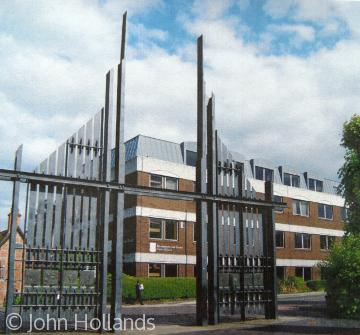The Triumphal Gateway, Basingstoke

The Basingstoke Triumphal Gateway
By various means including direct commissions from the Council, the town of Basingstoke has accumulated an exceptional collection of modern outdoor public art work for a town of its size.
The largest is the ‘Triumphal Gateway’ commissioned by the Council and erected in 1992 at the eastern end of the pedestrianised London Street where it meets New Road at right angles and looks towards the end of London Road opposite. Once London Road and London Street were part of a main traffic artery through the town; this function has been taken over by ring roads, but the spot still has the air of a point of transition between the outskirts and the town centre, and it was here, or near here, that a number of temporary triumphal arches have been erected in the past to mark coronations and other royal occasions.
The Gateway was designed by Hampshire ‘artist blacksmith’ Peter Parkinson as a ‘modern complement’ to the old buildings nearby, and to frame the ‘powerful sense of perspective’ one gets when looking from it along the straight London Street towards the Market Place at its other end. A line of closely spaced vertical flat steel bars on either side of the open gateway gives a vertical emphasis to the structure which is angled at the top to match the roof profile of nearby historic buildings such as the 1608 Sir James Deane almshouses on its southern side and Goldings a short distance away in London Road. Some of the bars extend above this profile to convey a suggestion of organ pipes and triumphal music.
It is part of Peter Parkinson’s design philosophy to combine large structures with small pictorial images ‘to draw people in and encourage them to explore the piece’. Thus he and his assistant, Trevor Forester, produced designs for sixteen boldly executed low relief bronze panels fixed to the Gateway on which are images that reflect aspects of the town’s history and culture. Some images are thematic such as those that draw attention to Basingstoke as a transport hub, and as a centre for shopping, sport and entertainments, whilst others refer to particular episodes in the town’s history such as the siege of the royalist stronghold, Basing House, by the forces of Oliver Cromwell. One panel depicts Basingstoke’s entry in Domesday Book.
The bronze panels were cast by the lost wax process at the world renowned Morris Singer Foundry which was located in Basingstoke at that time, whilst the steelwork was fabricated by a firm of craftsmen run by ‘art blacksmith’ Richard Quinnell with whom Peter Parkinson has undertaken a number of joint commissions.
The Gateway has had its admirers from the start, but when it was first erected it provoked fierce criticism on account of its size, its modernity, its £50,000 cost and what some saw as its unsuitability for a conservation area. However when Lord Palumbo, the Chairman of the Arts Council, saw it soon after it had been put up, he commented that ‘in the course of time, critics will come to terms with it and it will become a natural part of the landscape’. Many local people – though not all – now appear to have accepted it as such.
Content derived during research for the new VCH Hampshire volume, Basingstoke and its surroundings.


